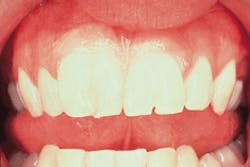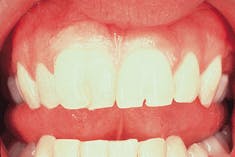Case #2
A 22-year-old male visited a general dentist for a checkup. Oral examination revealed two abnormally large and misshapened maxillary central incisors.
Joen Iannucci Haring, DDS, MS
History
The patient stated that he had previously been seen by a general dentist for regular dental examinations and routine restorative dental treatment. The previous dentist had commented on the unusual appearance of the large incisor teeth, but did not suggest a diagnosis or recommend treatment.
The patient appeared to be in a overall good state of health at the time of the dental visit. No significant problems were noted during the medical history, and no medications were being taken by the patient at the time of the dental examination.
Examinations
No unusual or abnormal findings were identified during the extraoral examination. The intraoral examination revealed a dentition in good state of repair with two large misshapen maxillary central incisor teeth (see photo).
Further examination revealed no other teeth with a similar appearance. The patient`s dentition consisted of a total of 28 teeth - 14 in the maxillary arch and 14 in the mandibular arch. No wisdom teeth were present. Examination of the oral soft tissues revealed no unusual findings, and no bony abnormalities were noted.
Clinical diagnosis
Based on the information presented, which of the following is the most likely clinical diagnosis?
* concrescence
* fusion
* gemination
* dilaceration
* taurodont
Diagnosis
_ gemination
Discussion
The term geminate means paired, or occurring in twos (from Latin geminatus, meaning twin). Gemination is a developmental dental anomaly that occurs when a single tooth germ attempts unsuccessfully to divide. The result is the incomplete formation of two teeth. The cause of this aborted twinning is unknown.
Clinical features
Gemination affects the deciduous dentition more frequently than the permanent dentition and is most often seen in the anterior regions. The deciduous mandibular incisors and the permanent maxillary incisors are most often affected.
Clinically, a geminated tooth appears as a "double tooth" or two crowns joined together with a notched incisal area. The resultant crown appears large and bifid or cloven.
Radiographic features
The dental radiograph is helpful in examining gemination. On a dental radiograph, a geminated tooth appears as a large, anomalous crown with a single, large root and pulp canal that may or may not be partially divided (see radiograph).
Diagnosis
Gemination may be confused with fusion, another developmental dental anomaly. The term fusion refers to Othe abnormal joining of adjacent parts.O Fusion results in the union of two adjacent tooth germs and may be complete or incomplete, depending on the stage of development of the adjacent tooth germs at the time of contact.
Early contact of adjacent tooth buds may result in a single, large tooth. Later contact may result in the union of crowns or roots only. Like gemination, fusion affects the deciduous dentition more frequently than the permanent dentition and is most often seen in the anterior regions.
The diagnosis of gemination is made based on the clinical and radiographic features described. Clinically, because a geminated tooth resembles a fused one, it is often difficult to distinguish between the two. Therefore, in order to differentiate gemination from fusion, the presence or absence of adjacent teeth must be considered.
With gemination, the teeth normally adjacent to the geminated tooth are present. With fusion, a tooth adjacent to the fused tooth is missing from the dental arch.
Management
Geminated teeth may present appearance, spacing, occlusion, and periodontal problems. When the maxillary anterior region is involved, a geminated tooth poses an esthetic problem and, consequently, presents a prosthetic challenge as well.
Some permanent geminated teeth may be reshaped with a restoration that mimic two crowns. Others may require extraction and replacement with a bridge for a more esthetic appearance.
Joen Iannucci Haring, DDS, MS, is an associate professor of clinical dentistry, Section of Primary Care, The Ohio State University College of Dentistry.

